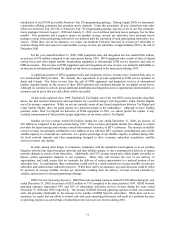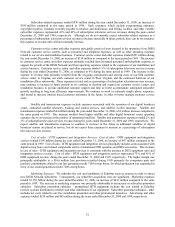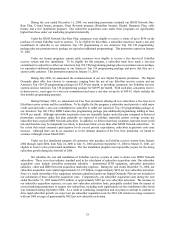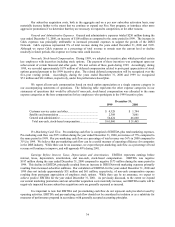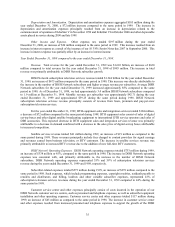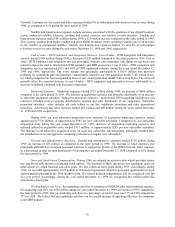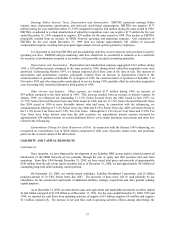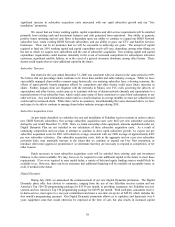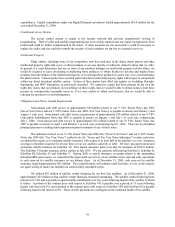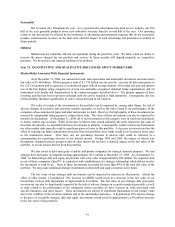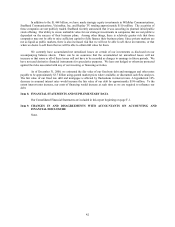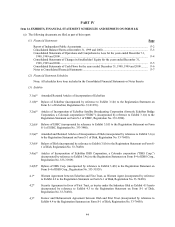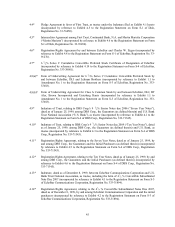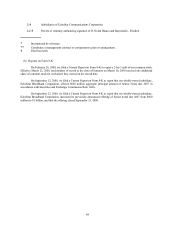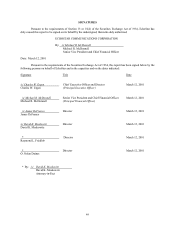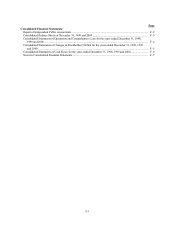Dish Network 2000 Annual Report Download - page 43
Download and view the complete annual report
Please find page 43 of the 2000 Dish Network annual report below. You can navigate through the pages in the report by either clicking on the pages listed below, or by using the keyword search tool below to find specific information within the annual report.41
Seasonality
Our revenues vary throughout the year. As is typical in the subscription television service industry, our first
half of the year generally produces lower new subscriber revenues than the second half of the year. Our operating
results in any period may be affected by the incurrence of advertising and promotion expenses that do not necessarily
produce commensurate revenues in the short-term until the impact of such advertising and promotion is realized in
future periods.
Inflation
Inflation has not materially affected our operations during the past three years. We believe that our ability to
increase the prices charged for our products and services in future periods will depend primarily on competitive
pressures. We do not have any material backlog of our products.
Item 7A. QUANTITATIVE AND QUALITATIVE DISCLOSURE ABOUT MARKET RISK
Market Risks Associated With Financial Instruments
As of December 31, 2000, our unrestricted cash, cash equivalents and marketable investment securities had a
fair value of $1.464 billion. Of that amount, a total of $ 1.374 billion was invested in: (a) cash; (b) debt instruments of
the U.S. Government and its agencies; (c) commercial paper with an average maturity of less than one year and rated in
one of the four highest rating categories by at least two nationally recognized statistical rating organizations; and (d)
instruments with similar risk characteristics to the commercial paper described above. The primary purpose of these
investing activities has been to preserve principal until the cash is required to fund operations. Consequently, the size
of this portfolio fluctuates significantly as cash is raised and used in our business.
The value of certain of the investments in this portfolio can be impacted by, among other things, the risk of
adverse changes in securities and economic markets generally, as well as the risks related to the performance of the
companies whose commercial paper and other instruments we hold. However, the high quality of these investments (as
assessed by independent rating agencies), reduces these risks. The value of these investments can also be impacted by
interest rate fluctuations. At December 31, 2000, all of our investments in this category were in fixed rate instruments
or money market type accounts. While an increase in interest rates would ordinarily adversely impact the fair value of
fixed rate investments, we normally hold these investments to maturity. Consequently, neither interest rate fluctuations
nor other market risks typically result in significant gains or losses to this portfolio. A decrease in interest rates has the
effect of reducing our future annual interest income from this portfolio, since funds would be re-invested at lower rates
as the instruments mature. Over time, any net percentage decrease in interest rates could be reflected in a
corresponding net percentage decrease in our interest income. During 1999 and 2000, the impact of interest rate
fluctuations, changed business prospects and all other factors did not have a material impact on the fair value of the
portfolio, or on our income derived from this portfolio.
We also invest in debt and equity of public and private companies for strategic business purposes. We had
strategic debt and equity investments totaling approximately $3.9 million at December 31, 1999. As of December 31,
2000, we held strategic debt and equity investments with a fair value of approximately $90 million. We acquired stock
in one of those companies, OpenTV, in connection with establishment of a strategic relationship which did not involve
the investment of cash by us. None of these investments accounted for more than 40% of the total fair value of the
portfolio. We may make additional strategic investments in other debt and equity securities in the future.
The fair value of our strategic debt investments can be impacted by interest rate fluctuations. Absent the
effect of other factors, a hypothetical 10% increase in LIBOR would result in a decrease in the fair value of our
investments in these debt instruments of approximately $2 million. The fair value of our strategic debt and equity
investments can also be significantly impacted by the risk of adverse changes in securities markets generally, as well
as risks related to the performance of the companies whose securities we have invested in, risks associated with
specific industries, and other factors. These investments are subject to significant fluctuations in fair market value
due to the volatility of the securities markets and of the underlying businesses. A hypothetical 30% adverse change
in the price of our public strategic debt and equity investments would result in approximately a $9 million decrease
in the fair value of that portfolio.


